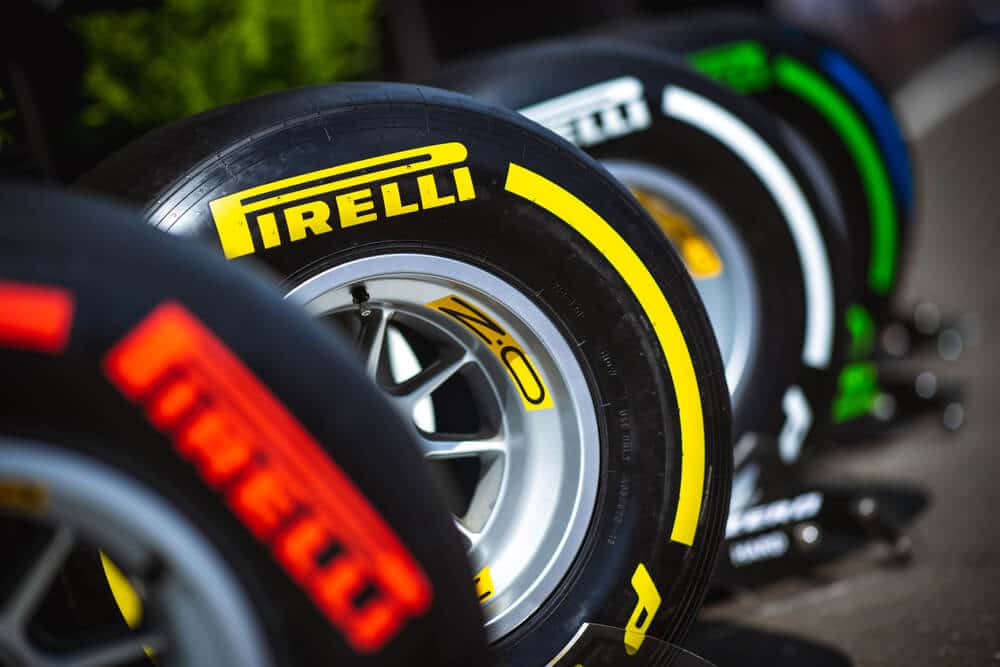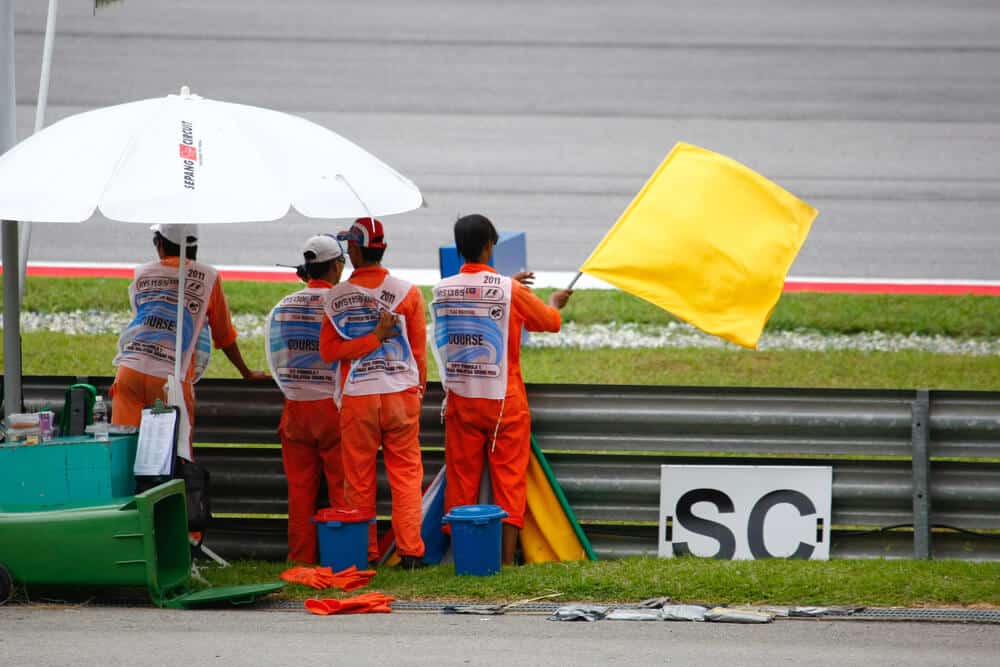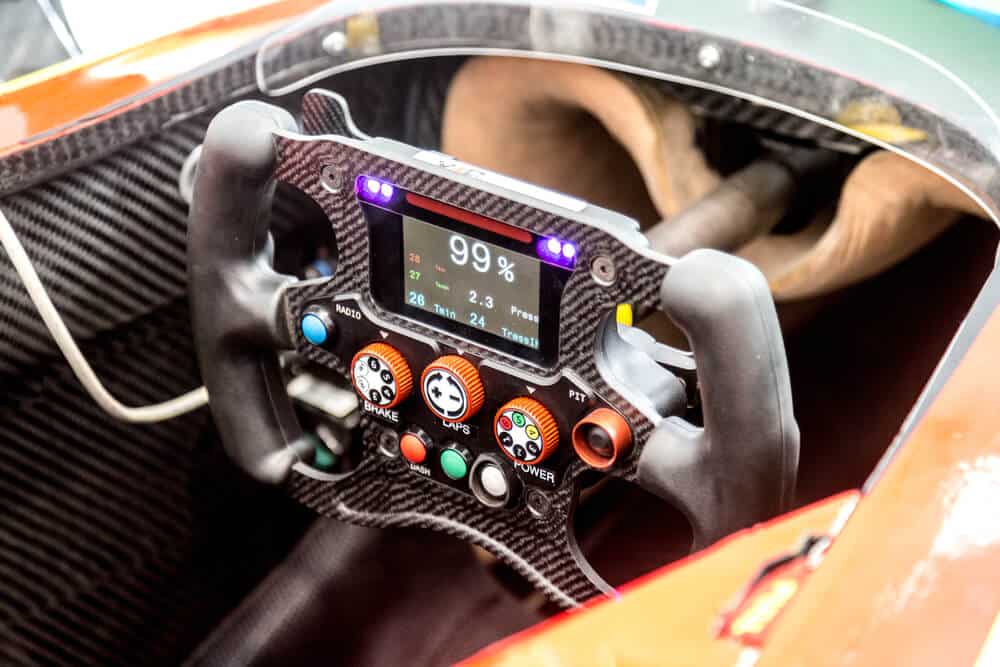Tires are one of the most important aspects of Formula 1 racing. They can make or break a race and have a major effect on its outcome.
The tires used in F1 cars are no ordinary tires.
They are specially designed to provide the optimal grip, performance and durability necessary for Formula 1 racing.
So, what exactly is special about F1 tires? In this article, we’ll take a look at everything you need to know about Formula 1 tyres.
Table of Contents
Watch this video to learn more about F1 tires.
Formula 1 Tires
The tires used in F1 are different from the normal tyres used on an everyday car. F1 tires are specifically designed to withstand extreme forces, high temperatures and large amounts of lateral load. The compound, construction, profile and shape of the tyre affect the performance on track.
Pirelli, the official F1 tire supplier provides teams with three dry-weather tyre compounds to choose from. Hard, medium and soft are the choices available. Moreover for wet conditions there’s intermediate and full wets to chose from. Depending on the track surface, temperature, humidity and other conditions, trams will adjust their strategies accordingly to maximise performance.
Here’s everything you need to know about the different tyres used in F1!
Key Takeaways
Here are some of the key aspects that you should know about regarding tires in Formula one:
- F1 tires are specifically designed to provide the optimal grip, performance, and durability necessary for Formula 1 racing.
- Different types of tires are used in different conditions such as wet, dry, damp, or intermediate track surfaces.
- F1 teams must choose their tires carefully based on the track conditions before each race.
- The amount of wear on a tire depends on the track surface and the driver’s driving style.
- F1 tires are constructed with a special rubber compound that helps provide maximum grip and durability.
- Tire temperature and pressure are carefully monitored during the race.
Tire Construction and Materials
F1 tires are complex and sophisticated in their design and construction. To ensure the highest levels of safety, they are rigorously tested before being approved for use in Formula 1 racing.
The rubber compound used to make F1 tires is made up of four compounds dictated by the FIA regulations. They are highly specialized according to vehicle and track conditions. These tires are made by Pirelli who is the exclusive supplier of F1 tyres.
Importance of rubber compounds
The rubber compounds used in F1 tyres are of particular importance. They mainly consist of a combination of natural and synthetic rubber, carbon black, and other chemical additives. The combination of materials used in the compound can have an effect on qualities like its hardness or softness as well as its ability to grip the road.
The compounds also need to be strong and able to withstand extreme temperatures, large lateral forces, and rapid acceleration and deceleration.
Additionally, the tire compound also affects how quickly the tire degrades or “wears out” during a race as they are temperature sensitive. A tire that degrades quickly may provide better grip initially, but will lose performance. The tyres may need to be changed more frequently, which can impact the overall race strategy.
Pirelli has been experimenting with the design of its tires over the years. They have frequently introduced new compounds and structures in order to improve tire performance.
Tire tread patterns
If you’ve ever watched a Formula 1 race, you’ll have noticed that there are no treads on the tires. This is because tread patterns are not necessary for F1 tires as their performance does not depend on them.
Tire treads are normally used to improve traction in wet conditions, but Formula 1 cars don’t need this since they rarely race in the rain and even when they do, teams can choose from intermediate or full wet tires.
Slick tires, which have no tread at all, are the typical tire used in F1 races as they provide maximum grip on a dry surface. Many newcomers also raises the question why do F1 cars use bald tyres? – This is why!
However, if conditions become wet, teams can switch to full-wet tires with special patterns designed to remove large amounts of water from the track surface.
Additionally, they can choose intermediate tires which are made from a softer compound than wets but also have some tread patterns to help dissipate water.
Tire sizes and regulations in F1
Formula 1 cars have traditionally used 13-inch wheel rims with tires measuring 26.4 inches (67 cm) in diameter, 30.5cm wide for the front, and 40.5cm for the rear tires. Intermediate tires are 5 cm wider than regular ones, and full wet tires are 10 cm wider.
In 2022, however, the rim size was increased to 18 inches (45.7cm) with the tire and rim diameter being 28.3 inches (72 cm). This new design has made F1 cars more responsive when turning, which has changed the way they handle the track.
It’s important to note that all of these measurements are dictated by the FIA regulations, in order to ensure equal performance for all teams.
-
FIA Regulations for F1 Tires Usage
When it comes to Formula 1 race weekends, all drivers must select 10 tire sets from the 20 tires including 13 dry, 4 intermediate, and 3 wet supplied by Pirelli. For the three practice sessions, a driver must use three sets of tires, with the first set returned to Pirelli before starting the next session. This allows Pirelli to study the tires for wear and their condition using identification tags.
For qualifying sessions, teams can choose from soft or wet tires depending on the conditions of the track. Soft tyres provide better grip and faster times, while wet tires are mandated by race directors if the track is slightly wet or waterlogged.
During the actual race, drivers must use two dry tire compounds. Additionally, they can keep their tyres warm before racing by wrapping blankets around them and heating only the outside surface of the tyres. This helps to maintain grip and traction for optimal performance and speeds.

Tire Strategy in F1
In Formula 1, tire strategy plays a crucial role in the success of a race. Teams must choose the right tires for each track in order to maximize performance and minimize risks of failure. The right tire compounds and strategies can help a team gain an advantage over its competitors.
Tire compounds are chosen based on the track conditions, driver style, and the team’s strategy for a particular race. For example, soft tires are best suited for short races with high speeds and tight turns. Harder compounds on the other hand are better for long distances with many straights.
Teams must also manage tire wear carefully. This means monitoring the pressure and temperature of tires during a race. They also need to check for any wear or damage. Ultimatly, the right tire strategy can help a team gain an edge on its competition and come out on top.
Impact of weather conditions on tire strategy
Weather conditions can significantly affect a team’s tire strategy. For example, if it’s raining on the day of a race, teams will typically opt for wet tires or intermediate tires. Both tyres have tread patterns designed to disperse water from the track surface.
On the other hand, if it’s sunny and dry, slick tires would be the ideal choice as they provide maximum grip and support better speeds. Teams must also consider air temperature when selecting tires, as hot weather can cause the tires to overheat and wear out more quickly.
Pit stop strategy and how it affects tire performance
Pit stops are an essential part of F1 racing and involve strategically changing the tires on a car during a brief period of time. This can provide teams with an advantage over their opponents, as new tires offer superior performance compared to worn-out ones.
To maximize the benefit of a pit stop, teams must factor in various conditions such as weather and performance. Computer simulations are conducted to find the ideal time for a pit stop, taking into account all possible scenarios. This helps ensure that teams don’t lose any time when making a pit stop and can benefit from new tires for another leg of the race.
A good pit crew is key to executing a successful pit stop. They must work quickly to replace tires and get the car back on track with minimal time lost, which could offer an additional ten or twenty seconds of advantage over their opponents. Ultimately, the pit stop strategy can be the difference between victory and defeat.
Different types of tires used in F1
In Formula 1, Pirelli tires come in five different compounds: C1 (the hardest), C2, C3, C4 and C5 (the softest). However, recently Pirelli has announced that a new, harder compound, C0, will be introduced in 2023.
This new version of the C1 promises increased grip performance compared to its predecessor. Along with the C0 and C1 compounds, the other three tires (C2-C5) remain unchanged but feature a new structure for greater consistency during full races.
Let’s take a look at each tire used in Formula 1 and the purpose they serve.
Soft
The soft tires are designed for maximum grip on the track and provide the best performance in high-speed corners. They must be used carefully, however, as they tend to degrade quickly if pushed too hard.
Medium
The medium tires provide a balance between speed and durability. They offer good grip during the race while being able to withstand more wear than their soft counterparts. Teams opt for this type of tire when they want to get the most out of their car performance-wise but also ensure that it lasts for the duration of the race.
Hard
The hard tires are designed to endure multiple laps of the track with better durability than their softer counterparts. They offer a more stable performance on the track, but their lack of grip often means that they are slower than other tires. Teams may opt for this type of tire when they need to maintain a consistent lap time throughout the race.
Intermediate
Intermediate tires are the most versatile type of tire when it comes to racing in wet conditions. They feature green walls and blue markings and offer greater grip than full-wet tires, making them a favored choice among teams and drivers. They can be used in almost any rain condition, providing superior performance until the track is ready for slick tires.
Full wets
These full-wet tires are specially designed for use in extreme rain conditions. They feature thicker tread blocks to help give drivers more grip on the track, and they can displace up to 60 liters of water at 300 kilometers per hour.
These tires should only be used when there is standing water on the track as they are ineffective in a drying track environment. Drivers typically prefer intermediate tires when possible in order to make the most of their performance.
Grooved tires
Grooved tyres were introduced to Formula One in 1998 as a safety measure to reduce cornering speeds. The grooves decreased the contact patch between the tyre and the track, reducing grip and making it more difficult for drivers to maintain high speeds.
The grooves were gradually reduced and then removed completely in 2009, leading to faster lap times and more exciting racing.
Tire Testing and Development
Formula 1 teams rely on tire manufacturer Pirelli to provide them with the highest quality tires that can handle the various track and weather conditions they encounter. To ensure this, Pirelli conducts detailed tests and simulations to develop new tires that meet the demands of F1 racing.
How tire manufacturers develop and improve their products
Manufacturers of Formula 1 tires are constantly striving to improve their products. To accomplish this, they use virtual models and data acquisition tools to generate predictions about how the tires will behave in various circumstances.
Furthermore, simulated tests are used to decide how well a tire will perform under varying loads and orientations. To get an accurate perspective of real-world performance, lab testing is also employed to measure the force of a tire while it is in motion.
Additionally, teams capture on-track information from sensors on cars and use this data to fine-tune the design of their tires. By using these methods, tire makers are able to provide F1 racers with the optimal grip, performance, and durability for their vehicles
Data analysis in tire development
With the advancement of technology, the amount of data available to tire manufacturers has increased drastically. This data is used in various ways to identify areas where improvements can be made.
With each tire being an incredibly complex system, data analysis is used to better understand each tire’s performance. The data is analyzed for factors such as grip levels, temperatures, and wear rate over a range of conditions. The information gathered allows manufacturers to quickly identify potential changes that can be made to improve the tires in future developments.
This is the reason why Pirelli is constantly pushing the boundaries of tire performance, as their data analysis helps them to refine and improve each iteration. This allows F1 teams to gain an edge over their competition, with better grip and improved efficiency on the track.
The importance of tire testing for F1 teams
Tire testing is an important part of the F1 experience. Teams need to be sure that their tires are up to the challenge, as even a small difference in performance can mean victory or defeat.
To ensure that the tires meet their expectations and generate the best performance possible, teams typically perform tire tests during the pre-season and throughout the year. These tests range from analyzing data to putting the tires through extreme conditions on the track.
The data gathered in these tests provides teams with invaluable insight into how their tires will perform over different surfaces and weather conditions. This helps them to make well-informed decisions when choosing which tires to use for each race.
Challenges and Controversies
Although tire manufacturers are constantly innovating to create the best possible tires for F1 drivers, there have been a few controversies and challenges surrounding the development of these tires.
The impact of tire failures on races (and safety concerns)
It goes without saying that tire failures can have a massive impact on the outcome of a race. When tires fail, drivers are faced with reduced grip and can lose control of their vehicles, resulting in dangerous situations for drivers and spectators.
For example, during the 2021 Azerbaijan Grand Prix, Max Verstappen experienced a rear-left tire failure on the main straight, forcing him to retire from the race. This sparked a debate over whether or not these failures were due to a manufacturing fault, with Red Bull voicing concern over the quality of tires produced by Pirelli.
Although tire manufacturers take every precaution to ensure that their products are of the highest quality, accidents can still happen. To minimize this risk, drivers must regularly check the condition of their tires and replace them when necessary
Controversies surrounding tire supplier contracts and selection
There have been a few controversies and challenges surrounding the development of Formula 1 tires, most notably those related to tire supplier contracts and selection. The most famous incident of this kind was the disastrous 2005 race at Indianapolis, in which only six cars were able to compete.
This highlighted the issue of redundant development costs incurred by three separate tire manufacturers, which led to a reconsideration of having only one supplier in order to save costs and ensure fairness. With only one supplier, all teams would have access to the same tires and levels of technology, making for a more level playing field.
In 2011, Pirelli was chosen as the sole tire supplier for F1. This helped to reduce costs and to provide a more level playing field, allowing teams and drivers to focus on racing without worrying about the tires.
Recent rule changes and their impact on tire performance
The most recent rule change regarding F1 tires that is to be implemented in 2023 requires drivers to use specific tire compounds during different stages of qualifying for two events. This rule requires teams to use the hard tire in Q1, the medium tire in Q2, and the soft tire in Q3. Additionally, the regulations also limit the number of available sets of tires during a race weekend to 11 sets instead of 13.
This change of tire regulations seeks to reduce waste produced by unused tires and also encourages drivers to make use of a variety of tires during the course of their race weekend.
Frequently asked questions
How are tire compounds chosen for each race in Formula 1?
What happens when a tire fails during a race in Formula 1?
How do F1 teams test and develop their tires?
Conclusion
Formula 1 tires are an essential part of the sport, as they can make or break a team’s performance. The development and selection of F1 tires is heavily regulated to ensure fair competition amongst teams while also allowing them to choose their desired tires based on the conditions at each race.
Despite the strict regulations, tire failures can still occur and have a major impact on races. It is important for drivers to regularly check the condition of their tires to ensure safety during a race. Ultimately, tire selection and condition can be the deciding factor in a race, making it an essential part of Formula 1.
Article sources
Learn more about Formula One
Want to learn more about F1? Then visit our Formula 1 glossary and dictionary.



